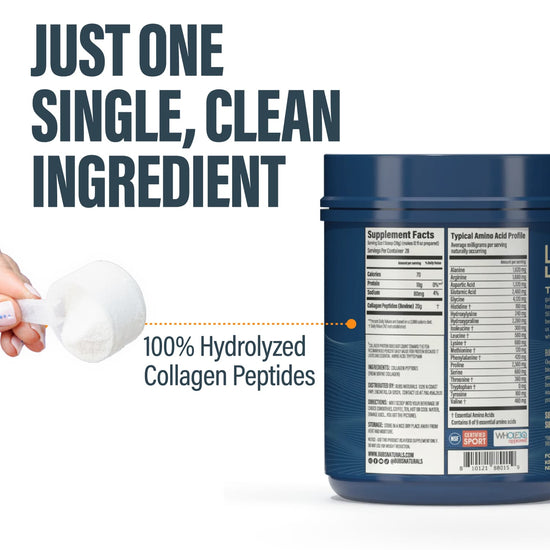Table of Contents
- Introduction
- Understanding Collagen Peptides
- The Importance of Iron
- The Connection Between Collagen and Iron Absorption
- Incorporating BUBS Naturals Collagen Peptides into Your Routine
- Supporting Your Iron Needs
- Conclusion
- FAQ
Introduction
When we think about wellness supplements, collagen peptides often take center stage, celebrated for their potential benefits to skin, hair, nails, and joint health. But amidst the myriad of questions surrounding these popular products, one stands out: Is there iron in collagen peptides? This question is more than just a curiosity; it touches on the broader topic of nutrient absorption and how we can support our bodies effectively.
In our journey toward optimal health, understanding the nutritional content of supplements like collagen is crucial. Iron, an essential mineral for bodily functions, plays a pivotal role in oxygen transport, energy production, and overall vitality. However, many may not realize that collagen peptides, while being a great source of protein, do not inherently contain iron.
In this blog post, we will delve into the relationship between collagen peptides and iron, exploring their nutritional profiles and how collagen can indirectly support iron absorption. We’ll also discuss the importance of iron in the diet and how our clean, functional supplements at BUBS Naturals can contribute to your wellness journey. By the end of this post, you’ll have a comprehensive understanding of collagen peptides, their role in supporting health, and how they fit into a balanced diet.
Let’s embark on this exploration together, looking closely at the science behind collagen peptides and their interaction with iron.
Understanding Collagen Peptides
What are Collagen Peptides?
Collagen peptides are short chains of amino acids derived from collagen, the most abundant protein in the body. Found in connective tissues, skin, bones, and cartilage, collagen provides structural support and elasticity. When hydrolyzed (broken down), collagen transforms into peptides that are easier for the body to absorb.
Nutritional Profile of Collagen Peptides
While collagen peptides are primarily composed of amino acids like glycine, proline, and hydroxyproline, they are low in other important nutrients, including iron. A typical serving of collagen peptides may contain:
- Calories: Approximately 70-100
- Protein: 18 grams or more
- Fat: 0 grams
- Carbohydrates: 0 grams
- Iron: Typically 0 mg
This absence of iron highlights a key point: while collagen peptides are excellent for supporting skin elasticity and joint health, they do not contribute to iron intake.
The Role of Amino Acids in Collagen
The amino acids in collagen peptides play various roles in the body. For instance, glycine is known for its calming effects, while proline supports collagen synthesis itself. However, none of these amino acids provide iron directly.
The Importance of Iron
Why Is Iron Essential?
Iron is vital for several bodily functions, including:
- Oxygen Transport: Iron is a key component of hemoglobin, which carries oxygen in the blood.
- Energy Production: It plays a role in cellular respiration and energy metabolism.
- Immune Function: Adequate iron levels help maintain a healthy immune system.
Iron Deficiency and Its Effects
Iron deficiency is one of the most common nutritional deficiencies worldwide and can lead to anemia, fatigue, and impaired cognitive function. Symptoms of iron deficiency can include:
- Fatigue and weakness
- Pale skin
- Shortness of breath
- Dizziness
Given the importance of iron, it’s crucial to ensure that we receive adequate amounts through our diet.
The Connection Between Collagen and Iron Absorption
While collagen peptides do not contain iron, they may have an indirect role in enhancing iron absorption. Recent studies suggest that certain collagen-derived peptides can stimulate the body's mechanisms for iron absorption. For example, specific amino acids in collagen might support the absorption of non-heme iron (the type found in plant foods) by promoting a more favorable environment in the gut.
How Collagen Peptides May Enhance Iron Absorption
Some research indicates that collagen peptides can aid in increasing the absorption of non-heme iron by:
- Chelation: Collagen peptides may act as chelators, binding to iron and enhancing its solubility and absorption in the intestines.
- Supporting Gut Health: Collagen contributes to gut integrity, which may improve nutrient absorption overall, including iron.
This means that while collagen peptides themselves lack iron, they can potentially create conditions that support better iron utilization when consumed as part of a balanced diet.
Incorporating BUBS Naturals Collagen Peptides into Your Routine
At BUBS Naturals, we believe in a no-BS approach to wellness. Our collagen peptides are made from grass-fed, pasture-raised bovine hides, ensuring a clean source of high-quality protein. With no artificial additives, our collagen peptides mix effortlessly into your favorite beverages, making it easy to incorporate them into your daily routine.
How to Use Collagen Peptides
- Smoothies: Add a scoop of our Collagen Peptides to your morning smoothie for a protein boost.
- Coffee: Stir it into your coffee for a creamy texture without added calories.
- Baking: Use it in baking recipes to enhance the nutritional profile of your treats.
By integrating collagen peptides into a diet rich in iron sources — such as leafy greens, beans, lentils, and lean meats — you can maximize their benefits while supporting your body's iron levels.
Supporting Your Iron Needs
Dietary Sources of Iron
To ensure adequate iron intake, consider incorporating the following foods into your diet:
- Red Meat: Rich in heme iron, which is more easily absorbed by the body.
- Poultry and Fish: Good sources of heme iron as well.
- Legumes: Lentils, chickpeas, and beans provide non-heme iron.
- Leafy Greens: Spinach and kale are excellent non-heme iron sources.
- Nuts and Seeds: Pumpkin seeds and cashews are great for snacking.
Supplements for Iron
If dietary sources are insufficient, consider iron supplements. However, it’s important to consult with a healthcare professional before starting any new supplementation to ensure it's appropriate for your individual needs.
Conclusion
In conclusion, while collagen peptides do not contain iron, they can play a supportive role in enhancing iron absorption when included as part of a balanced diet. By understanding the nutritional profiles of the supplements we take, we can make informed choices that align with our wellness goals.
At BUBS Naturals, we are committed to providing high-quality, clean supplements that fit seamlessly into your lifestyle. Our Collagen Peptides are designed to support your wellness journey, and by combining them with iron-rich foods, you can ensure that you are nourishing your body effectively.
FAQ
1. Can I get enough iron from collagen peptides?
No, collagen peptides do not contain iron. They are primarily a source of protein and amino acids.
2. How can I enhance iron absorption?
You can enhance iron absorption by consuming vitamin C-rich foods alongside iron-rich foods, maintaining a healthy gut, and possibly incorporating collagen peptides into your diet.
3. What are the best food sources of iron?
The best food sources of iron include red meat, poultry, fish, legumes, leafy greens, and nuts.
4. Do BUBS Naturals Collagen Peptides support joint health?
Yes! Our collagen peptides are designed to support joint health, along with skin, hair, and nails.
5. How do I use BUBS Naturals Collagen Peptides in my daily routine?
You can add them to smoothies, coffee, or baked goods. They mix easily and can be incorporated into various recipes.
By focusing on a balanced approach to nutrition, we can empower ourselves to achieve optimal health and wellness. Together, let’s continue this journey toward a life of adventure, wellness, and purpose.
Written by:
Bubs Naturals

Collagen Peptides
Collagen peptides are your source for more vibrant hair, skin, and nails as well as healthy joints and better recovery. Collagen is referred to as the ‘glue’ that holds our bodies together. It is an incomplete protein that naturally declines in the body as we age, so supplementing with collagen peptides is key. Enjoy this heat-tolerant, unflavored collagen protein and live better, longer.
Starts at $42.30
Shop

